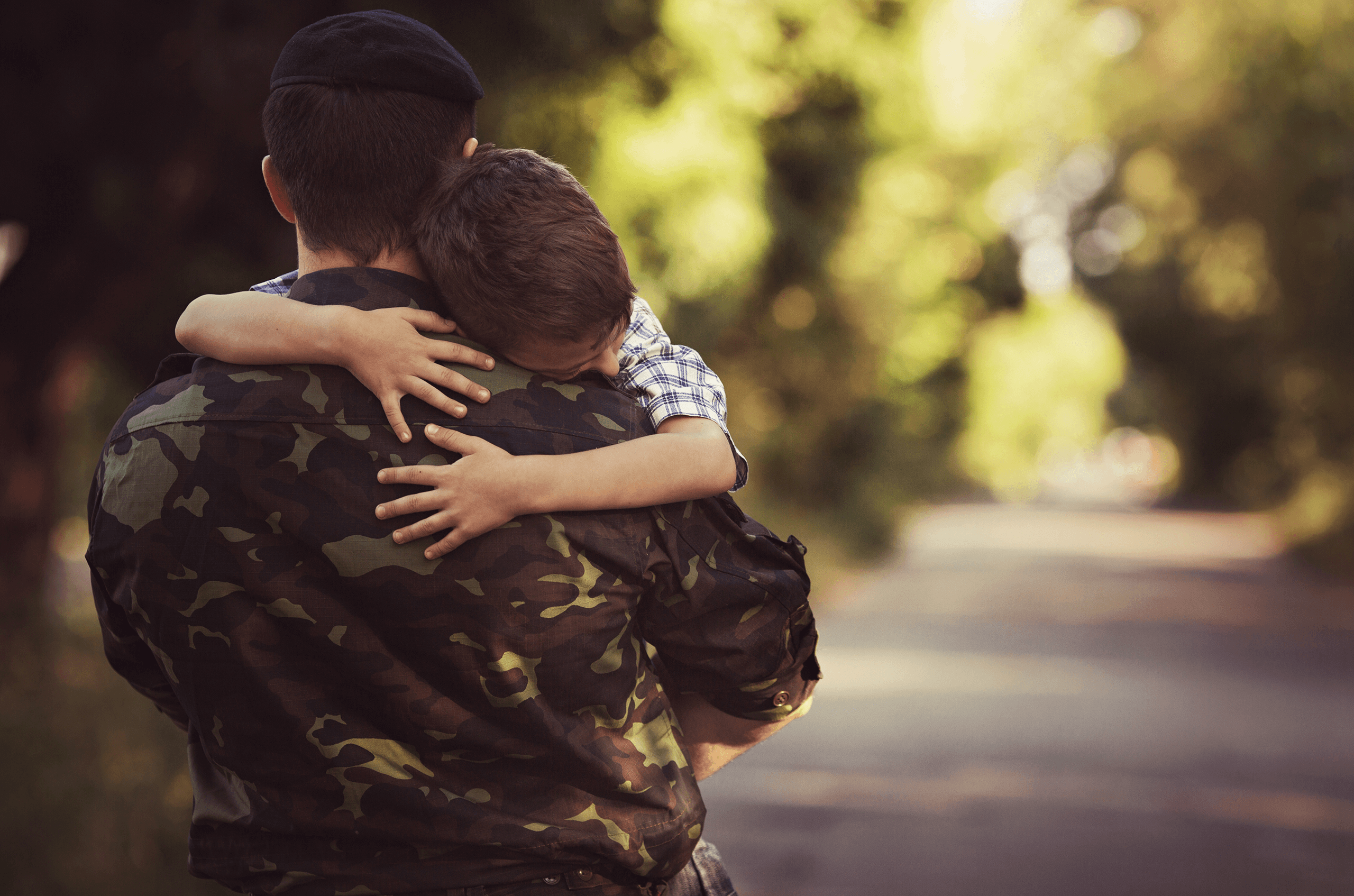
Tackling Post-Traumatic Stress as A Family Unit
By Joanne Strawder, MSW, Licensed Clinical Social Worker
and Guy Strawder, MMFT, MHA, USA Lieutenant Colonel (Retired); Resident, Marriage and Family Therapy
PTSD Affects Family Members Too
In our counseling practice, we have found that treatment of post-traumatic stress disorder is most effective when it is conceptualized as both an individual and a family system issue. While there is not a significant body of research within peer-reviewed journals regarding the effects of post-traumatic stress on the family, its clinical significance is readily apparent when counseling clients within the community of military personnel, law enforcement, and other occupations where there is a higher risk for exposure to emotional trauma.
This is one of the many reasons we remain so passionate about our support for Laughs for the Troops and Thomas Brown’s commitment to their inherent mission—to embrace the military community with family-friendly events that they can share in together, to raise awareness about PTSD [post-traumatic stress disorder], and to otherwise assist their journey towards recovery and to build greater resiliency as they move forward.


How PTSD affects the family -4

How PTSD affects the family -2

How PTSD affects the family -1

How PTSD affects the family -3
Heightened Risks Perpetuated During Deployment
Among high-risk families for PTSD, military families endure especially challenging stressors due to extended deployments that often last for a year or more. During these periods, families must naturally adapt to the absence of the deploying service member spouse with new roles, rules and hierarchies. These adaptations may manifest into new parental styles of discipline as the children age, and life circumstances may also influence how the remaining spouse will manage finances and organize other family activities. Meanwhile, if the service member spouse is deploying for combat operations, they will likely be exposed to multiple traumatic events including near-death experiences, perhaps witnessing the death of close friends, and often observing human atrocities that they would simply prefer to forget.
An Altered Home Life is Inevitable. The Soldier’s Reaction, Understandable
When the service member spouse returns home, reintegration is inevitably met with some tension based on how the roles, rules and hierarchies have changed. Hierarchies, in particular, may subvert prior leadership roles the service member spouse had held—and, since leadership is such an intrinsic facet to the identity of military personnel, the returning service member spouse may perceive the role-shifts as disrespectful and likely internalize his/her role as being dispensable.
If PTSD is another factor influencing this reintegration, then the family problems can deteriorate quickly. Relational conflicts elevate anxiety within the family and exacerbate the psychological health of the returning service member spouse. It is reasonable to assume that some measure of post-traumatic stress will be present when the service member returns. Some studies indicate that nearly 20 percent of returning service members will suffer from a clinical diagnosis of PTSD, and another 40 percent will report “stress-related symptoms” that impair their adjustment to returning home and “significantly compromise reintegration into a full, productive life” (Jonas, O’Connor, Deuster, Peck, Shake, & Frost, 2010, p. 6).
PTSD Symptoms Are Prevalent Among the Undiagnosed
Even if service member does not meet clinical criteria for PTSD, families must appreciate that almost every combat-related deployment will result in exposure to emotionally traumatic events. In addition, when service members remain in high-stress and high-risk environments over a period of weeks to months, the absence of sleep and reinforced hypervigilance will likely result in more anxiety, irritability and an inability to relax (Hoge, 2004, as cited in Department of Veterans Affairs and Department of Defense, 2010, p. 63; Peterson, Luethcke, Borah, Borah, & Young-McCaughan, 2011, p. 165).
Recognizing the Signs of Post-Traumatic Stress Disorder
How does the family respond when they suspect that their returning service member spouse/parent is suffering from PTSD? Perhaps the first thing to keep foremost in every family member’s mind is simply an awareness of the intense experience that their returning service member spouse/parent may have endured. Does he seem to isolate himself from the family? Does she avoid crowded places and choose not to join the family on shopping trips, baseball games or swim meets? Is he having trouble sleeping at night? Has sleep become such a problem that she decides to move out of the bedroom that she shared with the spouse? Does he seem to be drinking every evening, and usually having more than four drinks every night? Does he seem irritable and not willing to communicate? Does she become violent or seem to explode into anger? Does he seem disinterested in hobbies or activities that were previously enjoyable? Have arguments and increased distancing between the returning service member and her spouse become apparent?
Clinical PTSD
Clinical diagnosis of PTSD generally involves some measure of intrusive thinking that is connected to emotionally traumatic events, avoidance of situations that invite the possibility of re-experiencing the trauma (e.g., crowded areas), and the unmistakable evidence of hyperarousal or hypervigilance. You may also notice negative self-commentary that does not seem consistent with the person you knew before deployment.
Sub-Clinical PTSD & Secondary Transmission of Symptoms
If the relational bond between spouses becomes strained, even a sub-clinical presentation of post-traumatic stress can become problematic for the service member, and the underlying anxiety can worsen for all family members. Some research actually points to a secondary transmission of PTSD symptoms within the family system. This usually occurs as communications between the parents become frayed, and the children are left with attempting to interpret what they are observing. They may see their parents as sad, angry or distant, but “they are incapable of understanding the meaning of what is taking place in their home” (Dekel & Goldblatt, 2008, p. 285). Through both identification and parental projection by the returning service member, both the spouse and children can subconsciously adopt secondary transmission effects of PTSD. In other words, by avoiding the problem the family essentially learns to accommodate it and they consequently reinforce unhealthy symptoms of fear, avoidance, hypervigilance and irritability.
Step One
So, what can you do? The first step is to approach your service member spouse and communicate to them what you are observing. It will be a natural response for him or her to resist treatment at first. Let them know how important they are to you, and that you can tell that something is troubling them—and that they haven’t been themselves of late. State your confidence that having them seek assistance with a competent therapist will help both them and you. Let them know that seeking treatment simply means that the entire family may need help readjusting—and that just seeking good counsel to help them deal with the tension of returning home can often be of great benefit to them.

Insist When They Resist
If your service member spouse still resists, let them know that you still intend to seek treatment for yourself and possibly the family. There are multiple points of access for quality behavioral health specialists that are trained in PTSD, including: Military OneSource (http://www.militaryonesource.mil; 1-800-342-9647); the Department of Defense Peer Support Outreach and Call Center (https://www.betherepeersupport.org; 844-357-7337), the Coaching into Care Program offered by the Department of Veterans Affairs (http://www.mirecc.va.gov/coaching; 888-823-7458); or even self-referral through your TRICARE benefit. A good family therapist will not only help you with adjusting to the return of your service member spouse, they can also provide guidance on how to assist in their recovery. They may even encourage you to bring your children to one or more sessions. In addition, your seeking of treatment will likely be an encouragement for him to join you in couples therapy. Couples therapy can often be an excellent conduit for your service member spouse to develop an initial rapport with a therapist and to reduce the stigma associated with mental health services. Through this couples work, they will almost certainly come to realize the need to work on their own individual issues.
The Value of Recognition
The most important thing to remember within the family is just how deeply the service member spouse/parent connects with the value of loyalty to his or her “unit.” The ultimate unit for the service member is the family—at the heart of their service to country, they have been willing to give the greatest of sacrifices to ensure liberty, freedom and safety for their family and future generations. Make sure they know how much you appreciate that fact, how much they mean to you, and how proud you are of their service to our great Nation. Valor and honor are deeply ingrained in the spirit of the Soldier, Sailor, Airman, or Marine. When they understand just how hard you will fight for them, recovery and healing begins.

Joanne Strawder, MSW
Licensed Clinical Social Worker

Guy Strawder, MMFT, MHA
USA Lieutenant Colonel (Retired)
Resident, Marriage and Family Therapy
About the Authors
About the Authors: Guy and Joanne are co-principals of Revelations Counseling & Consulting, a psychological health and wellness practice providing both licensed counseling for individuals and families, and professional consulting to optimize the performance of health and social service systems. Guy is a retired Lieutenant Colonel from the US Army and Joanne was his “Household Six” for all 21 years of his service. They have now been married for 31 years and, based on their years of experience within the military community, they specialize in counseling service members and veterans regarding adjustment disorders, acute stress, post-traumatic stress, and other mental health issues. They also frequently work in co-therapy sessions to counsel couples and families.
References:
Department of Veterans Affairs and Department of Defense. (2010). VA/DoD clinical Practice guideline for management of post-traumatic stress. Washington, DC: Department of Veterans Affairs, Department of Defense.
Dekel, R., & Goldblatt, H. (2008). Is there intergenerational transmission of trauma? The case of combat veterans’ children. American Journal of Orthopsychiatry, 78(3), 281-289.
Jonas, W. B., O’Connor, F. G., Deuster, Peck, J., Shake, C., & Frost, S. S. (2010). Why total force fitness? Military Medicine, 175(8), 6-13.
Peterson, A. L., Luethcke, C. A., Borah, E. V., Borah, A. M., & Young-McCaughan, S. (2011). Assessment and treatment of combat-related PTSD in returning war veterans. Journal of Clinical Psychology in Medical Settings, 18(2).

































